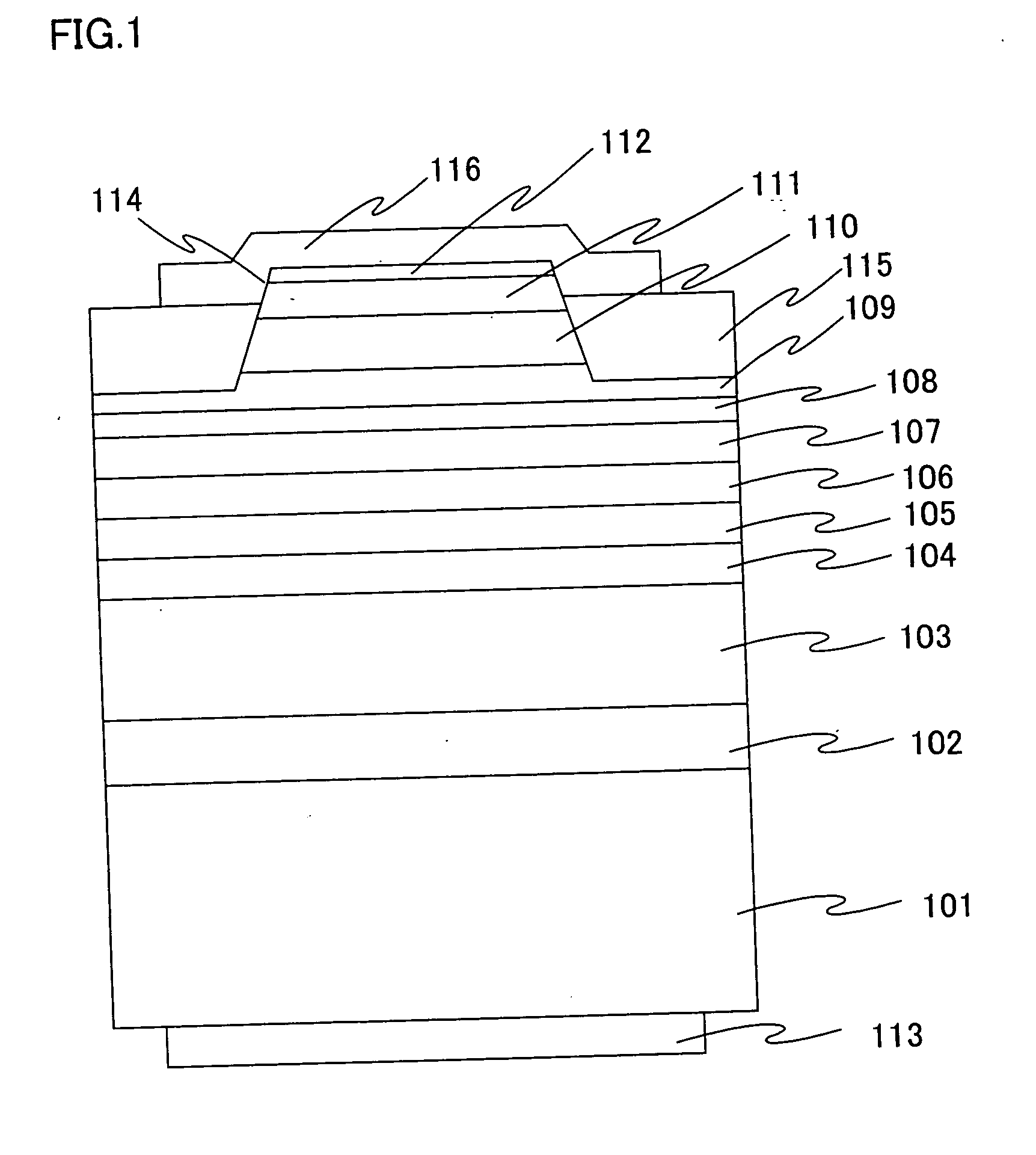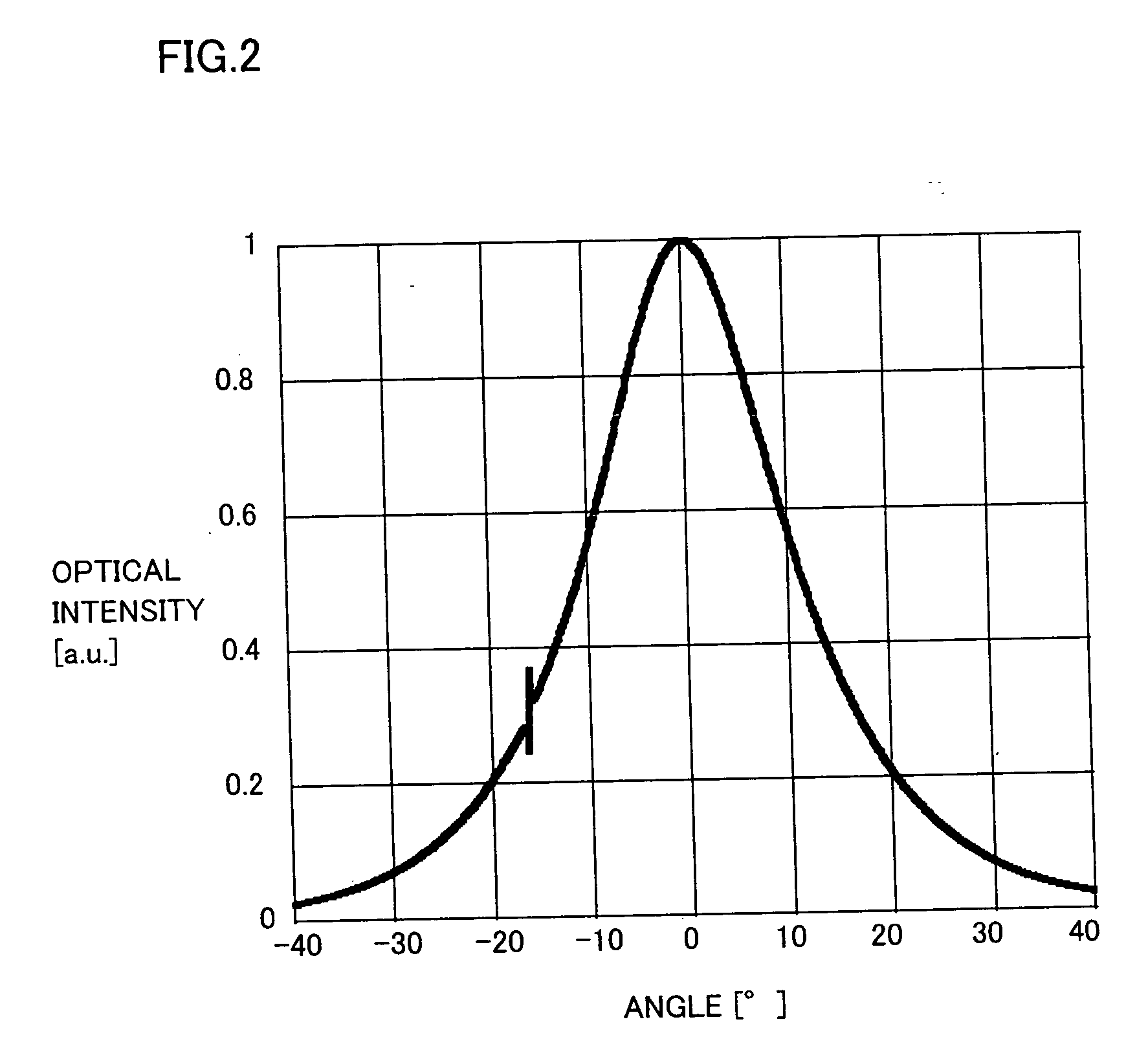Semiconductor laser device
- Summary
- Abstract
- Description
- Claims
- Application Information
AI Technical Summary
Benefits of technology
Problems solved by technology
Method used
Image
Examples
first embodiment
[0049] As a first embodiment, a process of fabricating the FIG. 1 nitride semiconductor laser device will be described. Initially, n-type GaN underlying layer 102 of 3 μm thickness is grown on n-type GaN substrate 101 at 1125° C., using hydrogen as a carrier gas, trymethylgallium (TMG) and ammonium as source gases, and silane (SiH4) as a dopant gas.
[0050] Then, at the same substrate temperature, hydrogen serving as a carrier gas, trymethy aluminum (TMA), TMG and ammonium serving as source gases, and silane serving as a dopant gas are used to grow first n-type clad layer 103 of Al0.05Ga0.95N doped with Si at a concentration of 3×1018 cm−3 to have a thickness of 1.8 μm. Similarly, second n-type clad layer 104 of Al0.1Ga0.9N doped with Si at a concentration of 3×1018 cm−3 is grown to a thickness of 0.2 μm. Similarly, third n-type clad layer 105 of Al0.05Ga0.95N doped with Si at a concentration of 3×1018 cm−3 is grown to a thickness of 0.1 μm.
[0051] Then, at the same substrate tempera...
second embodiment
[0062]FIG. 3 is a schematic front view of a laser device according to a second embodiment. As seen from FIG. 3 in comparison with FIG. 1, the second embodiment provides a laser device different from the first embodiment only in that a strain alleviation layer 120 is inserted between n-type underlying layer 102 and first n-type clad layer 103. Strain alleviation layer 120 can be made of n-type In0.09Ga0.91N for example.
[0063] More specifically, at a substrate temperature of 800° C., a gaseous mixture of nitrogen of 95% and hydrogen of 5% serving as a carrier gas, TMG, TMI and ammonium serving as source gases, and further, silane serving as a dopant gas can be used to form n-type In0.09Ga0.91N strain alleviation layer 120 doped with Si at a concentration of 5×1018 cm−3 to have a thickness of 0.03 μm.
[0064] The second embodiment provides an increased yield rate of 94% of the laser device which shows similar characteristics as in the first embodiment.
third embodiment
[0065] A third embodiment provides a laser device different from the first embodiment only in that dielectric layer 115 shown in FIG. 1 is replaced with a high-resistance or n-type AlGaN layer. Such a laser device of the third embodiment can bring about similar effects as in the first embodiment. The AlGaN layer can be deposited for example by MOVPE, MOCVD, HVPE, MBE, or other similar crystal growth technique. Furthermore, if sputtering is employed to deposit the AlGaN layer, the substrate's temperature can be set to 700° C. or less, which is lower than that for crystal growth, and this is preferable with a view to preventing thermal degradation of active layer 107.
[0066] Furthermore, the AlGaN layer preferably has an Al composition ratio higher than that of p-type clad layer 110 so as to realize a steady transverse mode up to a high output. Furthermore, if the Al composition ratios of the AlGaN layer and p-type clad layer 110 are made equal and the etching for forming ridged strip...
PUM
 Login to View More
Login to View More Abstract
Description
Claims
Application Information
 Login to View More
Login to View More - R&D
- Intellectual Property
- Life Sciences
- Materials
- Tech Scout
- Unparalleled Data Quality
- Higher Quality Content
- 60% Fewer Hallucinations
Browse by: Latest US Patents, China's latest patents, Technical Efficacy Thesaurus, Application Domain, Technology Topic, Popular Technical Reports.
© 2025 PatSnap. All rights reserved.Legal|Privacy policy|Modern Slavery Act Transparency Statement|Sitemap|About US| Contact US: help@patsnap.com



